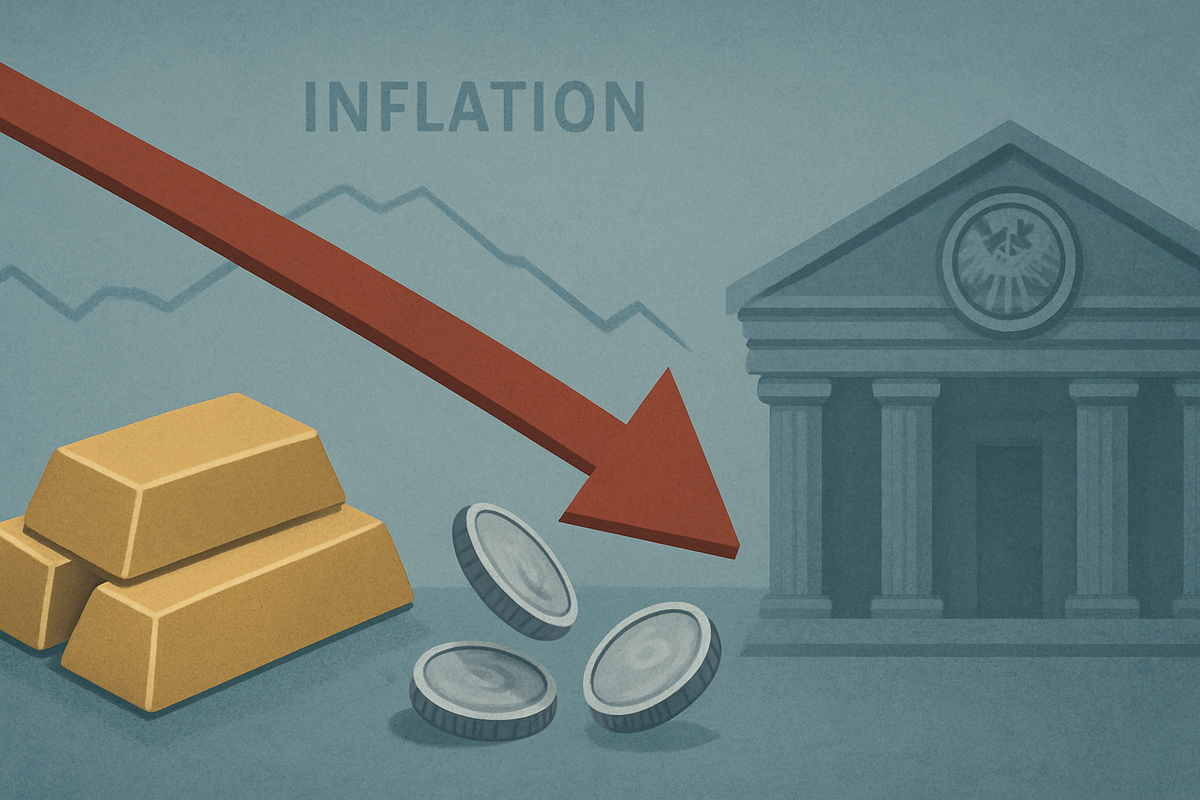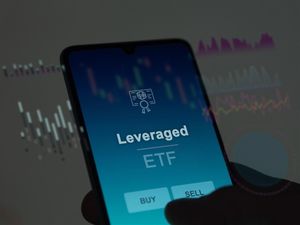
Gold and silver prices have experienced a significant downturn in October 2025, marking a notable shift after an extended period of robust gains. This recent slip is primarily attributed to a confluence of factors: widespread profit-taking by investors, clearer signals of easing US inflation, a strengthening US dollar, and the near-certainty of an upcoming Federal Reserve interest rate cut. While the immediate market reaction has seen significant selling pressure, analysts are largely characterizing this as a "healthy correction" within a broader long-term bullish trajectory for precious metals.
The retreat from their recent highs reflects a rebalancing of investor portfolios. With US inflation data showing a moderation (September CPI at 3.0%), and the Federal Reserve widely anticipated to adopt a more dovish stance, the urgency for safe-haven assets has temporarily diminished. This environment has prompted traders to lock in substantial profits accumulated over the past year, leading to increased volatility and a rotation into riskier assets as global economic sentiment improves.
A Nuanced Correction Amidst Dovish Fed Expectations
The recent slump in gold and silver prices in October 2025 represents a critical juncture for the precious metals market, coming after an extraordinary rally earlier in the year. Gold had surged an impressive 58-65% year-to-date, while silver recorded an even more staggering 69-90% increase. These substantial gains had pushed both metals into "overbought" territory, making a correction almost inevitable as investors sought to realize profits.
Specific details highlight the intensity of this downturn: gold experienced its largest single-day percentage decline in over a decade, dropping more than 6%, while silver plummeted nearly 10% in a single trading session. This sharp correction was exacerbated by a strengthening US dollar, which makes dollar-denominated commodities more expensive for international buyers, further dampening demand. Simultaneously, data revealed significant withdrawals from gold-backed Exchange Traded Funds (ETFs), marking the largest single-day drop in holdings by tonnage in five months, indicating a broad-based shift away from the asset class.
The timeline leading to this moment is crucial. Throughout late 2024 and much of 2025, persistent inflation concerns, geopolitical uncertainties, and aggressive central bank buying fueled the precious metals rally. However, recent economic indicators, particularly the September CPI report showing inflation at 3.0%—below the 3.1% forecast—have begun to shift market narratives. This easing inflation, coupled with a series of cautious statements from Federal Reserve officials, has solidified expectations for a 25-basis-point rate cut at the upcoming Federal Open Market Committee (FOMC) meeting on October 28-29, 2025. Key players involved include the Federal Reserve, whose monetary policy decisions are paramount; large institutional investors and hedge funds engaging in profit-taking; and individual traders looking for both shorting opportunities and long-term entry points.
Initial market reactions have been characterized by increased volatility, but also by what some analysts term "bargain buying" or "value buying." While the immediate sentiment is slightly bearish, many long-term investors view these lower prices as attractive entry points, suggesting underlying confidence in the long-term fundamentals of precious metals. The market is now keenly awaiting the Fed's formal announcement and, more importantly, its forward guidance on future monetary policy, which will dictate the near-term trajectory for gold and silver.
Companies that might win or lose from the event
The recent slip in gold and silver prices, alongside the anticipation of a dovish Federal Reserve, presents a mixed bag for companies operating within the precious metals sector and those sensitive to interest rate fluctuations. Mining companies, particularly those with high operating costs, stand to lose as their revenue per ounce of extracted metal decreases. For instance, major gold miners like Newmont Corporation (NYSE: NEM) and Barrick Gold Corporation (NYSE: GOLD) could see their profit margins squeezed if prices remain depressed for an extended period. Lower prices directly impact their top line, potentially leading to reduced capital expenditure, slower exploration efforts, or even deferred production from marginal mines. Similarly, silver producers such as Pan American Silver Corp. (NASDAQ: PAAS) and Wheaton Precious Metals Corp. (NYSE: WPM), which also hold significant silver streaming and royalty agreements, might experience a decline in their asset valuations and future revenue projections.
Conversely, companies involved in the fabrication and industrial application of precious metals could potentially benefit from lower input costs. Manufacturers using silver in electronics, solar panels, and medical devices might see improved margins, leading to increased demand for their products. While not directly listed as "winners" in the traditional sense of stock price appreciation due to the event, their operational efficiency could improve. Additionally, investors holding physical precious metals through ETFs, such as the SPDR Gold Shares (NYSEARCA: GLD) and iShares Silver Trust (NYSEARCA: SLV), have experienced a decline in their holdings' value in the short term. However, for those with a long-term bullish outlook, these lower prices could represent an opportune moment for accumulation.
Financial institutions and investment firms that have significant exposure to precious metals through derivatives or lending against metal inventories might also face adjustments. Banks that underwrite mining projects or provide hedging services could see shifts in their risk profiles and client demand. Furthermore, the broader implication of a dovish Fed, signaling lower interest rates, could indirectly benefit companies that are highly leveraged or sensitive to borrowing costs, as their debt servicing expenses might decrease. However, for the precious metals sector itself, the immediate impact of falling prices on miners' profitability and stock performance is the most direct consequence, potentially leading to a period of underperformance for some of the larger, more established players if the correction deepens or extends.
Wider Significance: A Shift in the Macroeconomic Landscape
The recent downturn in precious metal prices, driven by easing inflation and a dovish Federal Reserve outlook, signifies a broader shift in the macroeconomic landscape. For much of the past few years, gold and silver have acted as hedges against rampant inflation and economic uncertainty. The current development suggests a market recalibration, where the immediate threat of runaway inflation is perceived to be receding, and central banks are seen to be gaining control. This event fits into a trend of markets seeking clarity and stability, moving away from the "panic buying" that characterized earlier periods of economic distress. The potential ripple effects are substantial: a sustained period of lower precious metal prices could reduce exploration budgets for junior miners, impact the solvency of high-cost producers, and shift investment flows from safe havens back into growth-oriented assets like equities and corporate bonds.
Historically, periods of anticipated or actual interest rate cuts by the Federal Reserve have often presented a mixed picture for precious metals. While lower rates reduce the opportunity cost of holding non-yielding assets like gold, the initial reaction can sometimes be negative if the rate cut is perceived as a sign of economic weakness or if it strengthens the dollar by reducing inflation expectations. Comparisons can be drawn to post-crisis periods where central banks engaged in quantitative easing and rate cuts; initially, the market might interpret this as a sign of underlying economic issues, but eventually, the liquidity injection tends to support asset prices, including precious metals, albeit with a lag. The current situation, however, is unique in that the rate cut is anticipated against a backdrop of easing inflation, rather than accelerating inflation, which could temper the immediate bullish response typically associated with lower rates for gold.
Regulatory and policy implications are also at play. Should the Fed's dovish stance extend into 2026, it could encourage other central banks globally to follow suit, leading to a more synchronized easing cycle. This could influence currency valuations worldwide, indirectly affecting the purchasing power of gold and silver in different regions. Furthermore, the emphasis on a data-dependent approach by the Fed means that future inflation reports and employment figures will be scrutinized even more closely, potentially introducing short-term volatility based on each new economic release. The long-term impact on the credibility of central banks in managing inflation will also be observed, as the market assesses whether their current actions successfully navigate the economy towards a soft landing without reigniting inflationary pressures or triggering a deeper recession.
What Comes Next: Navigating a Shifting Investment Climate
Looking ahead, the precious metals market faces a pivotal period defined by contrasting short-term pressures and long-term potential. In the short term, continued volatility is highly probable as markets digest the implications of the Fed's dovish pivot and any subsequent economic data. Gold and silver prices may experience further downward pressure if inflation continues to ease more rapidly than expected, or if the US dollar strengthens significantly. Traders will be keenly watching the Federal Reserve's forward guidance for any hints regarding the pace and extent of future rate cuts beyond the anticipated October move. This could lead to tactical trading opportunities for those adept at navigating price swings, but also increased risk for passive investors.
In the long term, however, many analysts maintain a bullish outlook for gold and silver. The underlying structural drivers that propelled their earlier rally—such as persistent, albeit moderating, inflation concerns; accommodative central bank policies globally; ongoing geopolitical uncertainties; and elevated global debt levels—are unlikely to disappear entirely. While the immediate safe-haven demand might have lessened, the role of precious metals as a store of value and portfolio diversifier remains intact. Potential strategic pivots for investors could include re-evaluating their asset allocation, perhaps using this dip as an opportunity to accumulate at lower prices, particularly for those with a multi-year investment horizon. Mining companies might need to adapt by focusing on cost efficiencies and high-grade deposits to maintain profitability in a lower price environment.
Market opportunities could emerge for investors seeking value in oversold assets, particularly if the correction proves to be shallow and short-lived. Conversely, challenges include the risk of a deeper or prolonged correction if the economic outlook improves dramatically, reducing the appeal of non-yielding assets. Potential scenarios range from a rapid rebound if inflation proves stickier than currently anticipated or if geopolitical tensions escalate unexpectedly, to a more gradual recovery as global central banks continue to ease monetary policy, thereby increasing overall liquidity in the financial system. The outcome hinges significantly on the actual path of inflation, the Fed's subsequent actions, and the broader global economic and political landscape in the coming months.
Comprehensive Wrap-up: A Strategic Pause for Precious Metals
The recent slip in gold and silver prices represents a significant, albeit potentially temporary, recalibration within the broader financial markets. The key takeaways from this event are multi-faceted: a wave of profit-taking was inevitable after an extended rally; easing US inflation data has reduced the immediate urgency for safe-haven assets; and the anticipation of a dovish Federal Reserve rate cut has further contributed to a shift in investor sentiment towards riskier assets. While the short-term outlook suggests continued volatility and potential for further downside correction, the prevailing analytical consensus points to this being a healthy, necessary pause within a long-term bullish trend for precious metals.
Moving forward, the market will be keenly assessing the Federal Reserve's actions beyond the imminent October rate cut. The pace and magnitude of future monetary policy adjustments will be paramount in shaping investor behavior and the trajectory of gold and silver. Should the Fed's dovish stance lead to a sustained period of lower real interest rates, the opportunity cost of holding non-yielding assets would diminish, potentially reigniting demand for precious metals. Conversely, a stronger-than-expected economic recovery or a rapid deceleration of inflation could prolong the current correctional phase.
The lasting impact of this event lies in its role as a test of the underlying conviction in precious metals as a store of value. Despite the recent price action, the fundamental drivers—including ongoing geopolitical risks, global debt levels, and persistent central bank gold buying—remain largely intact. Investors should watch for several key indicators in the coming months: the actual inflation trajectory, the Fed's subsequent policy statements and rate decisions, the strength of the US dollar, and any significant shifts in global risk sentiment. This period offers both challenges and opportunities, requiring a nuanced and patient approach for those invested in or considering exposure to the precious metals market.
This content is intended for informational purposes only and is not financial advice





